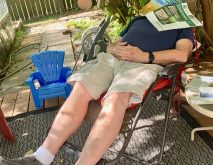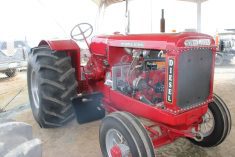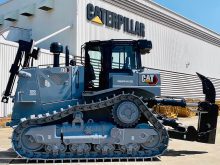Darren Lorentz didn’t hold out much hope of figuring out the make and model of a farm tractor from just the rusted-out frame of the machine that had sat in the brush near a popular southwest Edmonton park pathway for decades.
As a community resident walking the pathways of Tomas Opalinski Park for nearly 40 years, he says, every once in a while, he would venture off the path just to check on the remains of the tractor, which amounted to little more than a rusted frame and four wheels. It was a short distance off of the actual path sitting on a utility corridor. At one time he used to bring his own kids to check on the tractor … they named the spot Tractor Point.
“On my morning walks around the Blackmud Creek in Edmonton, I have been aware of an old tractor, or what’s left of it, for over 30 years,” says Lorentz. “I’d pop in and visit the old girl every once in a while, without giving much thought as to who she was. Recently, I thought I would like to get to know more.” His own research didn’t reveal too much but he figured the round-spoked rear wheels might be a clue for someone with great knowledge of farm machinery. That’s when he came to me.
Read Also

Managing through market or individual stock declines
Even the best of public-traded companies can periodically experience significant drawdowns, and a successful investor should be prepared to react — or not react — accordingly, Herman VanGenderen writes.
Of course, I only needed a quick look at the photos that Darren supplied to determine I didn’t have a clue, but, fortunately, I knew someone who might.
I had been in touch with Brian Manning, curator of the Agriculture and Industry Collections at the Reynolds-Alberta Museum at Wetaskiwin, just south of Edmonton, in the past. The Reynolds museum has an extensive collection of agricultural, industrial and transportation equipment and vehicles.
A few years ago, I was looking for information on the little grey Fordson tractors introduced to Canada in 1917 and Brian was able to help. I sent him the photos that Darren provided and a couple of days later he had the answer.
The mystery tractor frame sitting in the southwest Edmonton bush was originally a Cockshutt tractor.
“You gave me a good one to research, but I was able to identify the tractor,” says Manning. “It is what I believe is the remains of a circa 1939 Cockshutt 90 or 99 Standard tractor.
“The picture has the same front-end casting, hole for the hand crank, as well as the spring stops for the front axle. The main frame for the Cockshutt 80 is a totally different casting with the engine bolted to the sides of the casting, while the 90 and 99 were on mounts inside the casting.”

Manning says the tractors sold in Canada were painted red with cream wheel rims, while the ones sold in the United States were green with red rims. Another identifying feature was the unique grease fitting in the middle of the front wheels for lubricating the bearing. (I don’t know how I missed that….)
“The rear wheel on this one gave me a bit of trouble,” he says. “I have never seen (a Cockshutt) with round spokes, but advertising shows they actually manufactured them perhaps in limited quantities, as internal wheel weights would not have been able to be attached.” He says it is possible the tractor may also have been retrofitted with pull-type grader rear rims.
Discovering the make and model of the old tractor wasn’t a life altering experience, but Lorentz says it was good to know.
“Thanks for looking into this, I hope you enjoyed the adventure as much as I did,” says Lorentz. “I started out thinking it might be a tractor from the late ’30s but by focusing in on the wheels I was unable to find the round-spoked rear and non-spoke front and that sent me drifting off all over the place. Farmers are a resourceful lot, so I have no doubt that there may have been some modifications over the years. Thanks again for identifying my old friend.”
Lorentz also learned during his bit of research that this built-up area of Edmonton was mostly open farmland annexed into the city in the early 1970s. The annexation applied to about 700 acres, with part of that including a half section or more owned by farmer Tomas Opalinksi — hence the park name.
Lorentz says he has had no direct connection to agriculture over his life, other than summer visits to his grandparents’ farm in southern Ontario in that eight-, 10- and 12-years-of-age range. He remembers those as exciting visits for a “kid from the city.”
Manning says the museum is often asked to help identify old pieces of farm machinery and finding answers isn’t always as easy.
He said one challenge earlier this year involved a person who brought him a grainy picture of two combines probably from the early 1920s. The person wanted to know the makes. The machines were old and the photo quality wasn’t great.
“It took about a month or more when I was at a farm in eastern Alberta picking up a piece of equipment. And this place had a few relics sitting around and I took some pictures,” says Manning. “I got looking at these photos and I realized that’s it, that’s the combine I’d been looking for.”
Manning says there is a certain satisfaction in being able to do some detective work to help solve a machinery mystery. If you have any inquiries, contact Manning at [email protected].
















